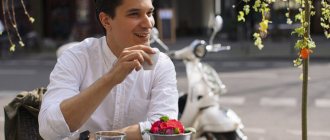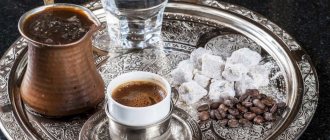The history of coffee is full of legends and myths
According to historical information, the first mention of unique aromatic grains dates back to the 9th century BC. It was during this period in Ethiopia, which is considered the birthplace of black coffee, that one of the sheikhs conducted his medical research and, in search of new medicinal plants, came across a strange bush-tree, dotted with equally strange fruits. From this time the official history of coffee begins, and initially the aromatic beans were positioned as a medicinal remedy. And in order to become the favorite drink of every second inhabitant of the Planet, the fruits of the coffee tree had to pass through several centuries.
In the mid-16th century, coffee, which was already known to selected representatives of the European nobility, was considered a very expensive and mystical drink. It was not for nothing that later (in the 18th century), the Italians came up with fortune-telling using coffee grounds, with the help of which one could look into both the past and the future.
There is another legend according to which a unique tree with fruits was first discovered not by a sheikh, but by an ordinary shepherd, whose goats, having tried the strange “berries,” began to behave more actively and excitedly. The shepherd did not dare try the effects of the fruit on himself, but told the abbot of the local monastery about the wonder. It was the abbot who, having experienced the tonic effect of the unique “ berries”, decided to use them to prepare invigorating decoctions.
Initially, the magical and invigorating decoction was available only to local monks, but after some time the secret of drinking left the walls of the monastery and was immediately picked up by villagers. Probably, from that moment on, the expansion of black coffee began and today, thanks to goats, a simple shepherd and monks, we can enjoy espresso or an exquisite latte in the morning, which helps us wake up and invigorate ourselves. Return to content
Appearance in Latin America
In 1714, the mayor of Amsterdam presented the French King Louis XIV with a coffee tree seedling. The king ordered it to be planted in the Royal Botanical Garden in Paris. In 1723, a young naval officer, Gabriel de Clue, received a sapling of the royal coffee tree. Despite a difficult voyage - terrible weather, a saboteur trying to destroy the plant, and a pirate attack - the officer managed to transport the coffee tree safely to Martinique (Antilles in the Caribbean).
The planted tree blossomed, and over the next 50 years, about 18 million coffee trees grew on the island. A seedling exported from France became the progenitor of all coffee trees on the Caribbean island, South and Central America.
Brazilian coffee owes its existence to Francis de Mello Paletta, who was sent by the emperor to French Guiana to buy beans. The French did not want to share, but the wife of the French ruler, enchanted by Francis, gave him a huge bouquet of flowers before he sailed from the island. Hidden in the flowers were enough beans to begin cultivating coffee.
Missionaries and travelers, traders and colonists continued to bring coffee beans to new lands. So, trees were planted all over the world. By the end of the 18th century, coffee had become one of the most profitable agricultural crops for export.
Varietal confusion
An equally complex issue related to coffee is still considered the division of the product into varieties and types. The average consumer, who can hardly be called a gourmet, probably still does not know what the difference is between types of coffee and its varieties, and how fruits grown in different countries, or even on different continents, can be used to create a mixture.
The confusion arose primarily due to the fact that the variety on the packaging of black coffee is written very rarely or not indicated at all. But you can always find mysterious inscriptions like “Arabica” or “Robusta”. So, Arabica and Robusta are not varieties of coffee, but types of coffee. As for varieties, they are indicated only if the contents of the package are a single variety; in all other cases, these are mixtures of different varieties, the formula of which is kept secret by the manufacturer and is considered a trade secret. After all, from year to year the taste of a particular product must be the same, otherwise the product will not have fans. But in order to maintain this intrigue, the manufacturer needs to carefully select coffee varieties every year and mix them into a single ensemble. This is not at all easy, since coffee is a mysterious product and depending on the weather conditions that existed at one time or another, the taste properties of the beans may differ.
As for the division into robusta and arabica, their grains also differ in their aroma and taste parameters, even within the same type, depending on the country of origin. And a person far from the coffee industry will probably not be able to determine which is Brazilian Arabica and which is Ethiopian, but the fact that they differ in taste will be confirmed after one sip. Return to content
Distribution in Europe
Coffee began to be consumed in Europe in the seventeenth century. The first time anyone could enjoy this exquisite drink was in 1626 in Rome. According to another version, this product appeared on the territory of European countries thanks to a botanist from Germany, Bellus.
The very first coffee shops were opened in the following cities:
- London (1652);
- Marseille (1671);
- Paris (1672).
Until the beginning of the eighteenth century, coffee was elevated to the title of the national drink of the Kingdom of Great Britain. By the beginning of 1702, there were already two thousand coffee houses in London. Women were prohibited from entering them. It was only in 1717 that the first shop was opened where the fair sex could enjoy a cup of tea. Coffee continued to be unavailable to them. This resulted in a gradual displacement of coffee. Tea took the lead.
It is worth noting that the word “coffee” was not used previously in Europe. In ancient times, this aromatic drink was called “Arab wine.”
Etymology has its mysteries
It is impossible to unequivocally answer where the word “coffee” came into modern language. Some people insist that the word came into the English dictionary from Dutch. So in 1598, when long-term sea expeditions were in full swing, and trade between countries was developing and flourishing, Dutch traders not only enriched their vocabulary with the new word “koffie”, but also pleased the local nobility with a new gastronomic delight. There is even a theory that coffee came to European languages from Turkey, or more precisely from the Turkish “kahve”.
Other historians insist that the ancestor of the word “coffee” was the Arabic word “qahwa”, which, however, was used to designate a type of local wine. It was not possible to trace the earlier etymology at a scientific level. Therefore, the researchers limited themselves to guessing that the word “qahwa” is the name of the area in Ethiopia where the unique fruits were first discovered. True, in Kaffa itself, the birthplace of the coffee tree, its fruits are called bunna or buno.
As for native speech, the situation is no less clear, which is also complicated by such a grammatical phenomenon as gender. And frankly, some lovers of this tonic hot drink still don’t know what type of their favorite drink is male or average.
Return to content
Where coffee grows - continents and coffee exporting countries
Today, the coffee tree grows in 70 countries around the world, in the so-called “coffee belt” of the earth - a tropical zone near the Equator.
The history of coffee begins with a story about Africa, since it is the country of this continent, Ethiopia, that is the birthplace of coffee. From there, in 1700, the Dutch took the seedlings of the plant and began cultivating it in Indonesia, on the island of Java. Gradually, the coffee tree began to be grown on plantations in Ceylon, Sri Lanka and India. Later, the plant began to be planted in South America, although it is considered the second homeland of coffee and the largest exporter of beans.
At the same time, not only Arabica, but also – especially – Robusta has become widespread. The unpretentiousness of the latter made it easy to cultivate in other countries, even in areas with difficult climates, while Arabica was capricious to environmental conditions. This led to the fact that the market was gradually filled with cheap varieties of grains, which were subsequently used to make instant drinks.
On a note! This is what led to the creation of the Jacobs coffee drink, the country of origin of which is Germany. Its enterprising inventor opened a factory for the production of the drink and various grains: he purchased both expensive Arabica varieties and cheaper Robusta varieties, and then mixed them, obtaining both inexpensive and tasty results.
Drink or eat?
19th century - in Russia, coffee is enjoyed not only by members of the imperial family and those close to the Court, but also by ordinary citizens. The uniqueness of the process of consuming black coffee in Russia was that it was not drunk, but bitten. If you look into the works of such geniuses as Goncharov, Ostrovsky or Gogol, then their characters “ allowed themselves to have a bite of coffee . ” And, probably, at this very moment, the drink was given the status of a masculine gender, since “ coffee ” could not be classified as either feminine or neuter.
Linguists still don't understand why a word ending in " e " was defined as masculine rather than neuter. Some researchers suggest that during the time of Peter the Great, when there was a widespread Europeanization of not only everyday life, but also Russian speech, some words were pronounced in an overseas manner, but at the same time they used “ native ” word forms in parallel. That is, at that time, in the chambers of the nobility they could “ a bite ” of coffee (definitely masculine), and coffee, and kohei, and kefa, and coffee, and coffee, and the coffee we are accustomed to today.
In any case, today there are three theories why the word “coffee” is defined not by the middle, but by the male gender. According to the first, coffee as a word that came into Russian speech, either from German, or from Dutch, or from Italian, is precisely masculine in these languages. According to the second, it is a drink, and the word and concept “drink” itself is not neuter, but masculine. And finally, according to the third theory, the male gender of the word “coffee” was inherited from its predecessor “coffee”. By the way, it is Peter the Great who should be given credit for promoting and popularizing this aromatic drink. Today it seems strange to us that once upon a time someone opposed the spread of this invigorating and such an exquisite drink. But Peter the Great had to fight a fair bit with the boyars and Old Believers, who for some reason called coffee a demonic potion.
True, the magical properties of grains and grounds were confirmed by Italian witches, who used them to perform rituals to predict the future. Well, for modern people coffee is:
- a wonderful tonic drink;
- raw materials for medicines;
- component of cosmetics;
- decorative material for creating crafts;
- a way to have a great time with friends;
- one of the tools for performing magical rituals.
And, probably, of all the questions that interest the most pragmatic modern residents of megacities, this is the question, what is the “gender” of coffee? And also why is the word ending in “e”, contrary to all grammatical laws, not neuter, but masculine? Return to content
English borrowings into Russian from the world of business
English is the international language most often used in high-level business negotiations. The terminology of the business world is based on words of English origin, so if you work in the field of economics, management, marketing and finance, you already know hundreds of English words. Let's present the most frequently used of them:
| Russian word | English word | Meaning |
| outsourcing | outsourcing - attracting resources from external sources | Transfer of certain types of work to third-party specialists on a contractual basis. |
| brand | a brand - brand, name | A brand of goods that is extremely popular among customers. |
| broker | a broker - intermediary, agent | An individual or legal entity that acts as an intermediary in concluding transactions on the stock exchange, and also acts on behalf of its clients. |
| deadline | a deadline - deadline, final date | Deadline for submitting work. |
| default | default - non-payment, negligence, defect | Failure to fulfill obligations to repay borrowed funds or pay interest on securities. |
| diversification | diverse - different, varied | Development of new (different) types of activities by the enterprise. As well as the distribution of investments between various objects. |
| dealer | a dealer - merchant, sales agent | A company that engages in wholesale purchasing of goods and selling them to consumers. Also a professional participant in the securities market. |
| distributor | to distribute - distribute | A representative of a manufacturing company who purchases goods from it and sells them either to retailers and dealers, or directly to the buyer. |
| investor | an investor - investor | A person or organization that invests money in projects in order to increase its capital. |
| crowdfunding | a crowd - a crowd; funding - financing | Funding of new interesting ideas with money or other resources by a large number of people on a voluntary basis, usually done through the Internet. |
| leasing | to lease - to rent out | A form of lending for the acquisition of fixed assets of an enterprise, in essence it is a long-term lease with a subsequent right of purchase. |
| marketing | marketing - market promotion, market activity | Organization of production and marketing of goods/services, which is based on the study of market needs. A marketing specialist is called a marketer or marketer. |
| management | management - management | Management of socio-economic organizations. |
| networking | a net - network; work - work | Establishing business contacts, creating a network of useful acquaintances for work. |
| know-how | to know - to know; how - how | Technology, a production secret that allows you to create a product/service in a unique way. |
| PR | public relations - public relations | Activities to create an attractive image of someone/something, including through the media. |
| prime time | prime - the best part; time - time | The time when the largest audience gathers near screens or near the radio |
| price list | a price - price; a list - list | Price list, a list of prices for goods and services of a particular company. |
| promoter | to promote - promote | A person who promotes a product/service on the market. |
| release | to release - release, publish | Release of a new product, for example, a film, music album, book, program, etc. |
| retailer | retail - retail sales | A legal entity that purchases goods wholesale and sells them at retail. |
| realtor | realty - real estate | Real estate sales specialist, intermediary between buyer and seller. |
| startup | to start up - start a project | A newly emerged company that builds its business on the basis of innovative ideas or technologies. |
| freelancer | a freelancer is a self-employed employee who provides his services to various companies | A person performing temporary work (work to order). |
| holding | to hold - to hold, to own | A company that owns controlling stakes in several enterprises and thereby exercises control over them. |
So black or black?
For a long time, the phrase “black coffee” indicated illiteracy in a person, since the word “coffee” in the native language is not neuter, but masculine. But language is a living organism, and if it does not change and evolve, it risks joining the ranks of “dead languages” such as Latin or Ancient Greek. In the process of its evolution, the language becomes simpler and adapts to modern realities. Thus, some words become archaisms, since the concepts they denote disappear from everyday life, while others, on the contrary, appear or are borrowed from other languages in order to denote innovative products or phenomena. In addition, in the process of linguistic evolution, the boundaries between the language of the upper strata of society and the “common people” are erased, and this is not surprising, because the division of society into classes and castes is also no longer relevant. Well, except that Royal English still exists at the court of the Queen of Great Britain. What do these linguistic features have to do with coffee? It turns out that it is the most direct. After all, since 2002, grammar has officially assigned coffee not only the masculine, but also the neuter gender, and today, if someone says that he wants black or hot coffee, it is no longer possible to blame him for lack of education.
But, there are certain limitations. Firstly, if you still want to seem like a person who knows how to express themselves competently and beautifully, then it is better to order black coffee, that is, use the masculine gender. Secondly, the neuter gender for the word “coffee” is only allowed in spoken language. And if during a conversation the mentioned neuter type of drink may not be noticed, then when writing it will be a gross mistake, fraught with a bad grade for students, and for an adult - with the stigma of “illiterate”. Return to content
Coffee varieties
Currently, botanists identify more than 40 species of coffee trees. However, only two are widely used for industrial purposes:
- Arabian (Coffea arabica) - the Arabica variety is made from it;
- Congolese (Coffea conephera, otherwise called Coffea robusta) - the Robusta variety is made from it.
Arabica
The Arabian coffee tree has many subspecies, and it is its harvests that provide three-quarters of the world's total coffee production. This is everyone's favorite Arabica coffee, which has a delicate taste - sweet and slightly sour. This flavor is given to the grains by the composition of the soil in which such trees grow best - with high acidity.
Arabian coffee trees are very sensitive to climatic conditions and are susceptible to various diseases, so cultivating them is quite difficult. This explains the high cost of Arabica beans.
Robusta
The Congo tree is not as susceptible to disease and is less sensitive to environmental conditions, so it is much easier to grow than the Arabian tree. From its harvests, Robusta is produced, the taste of which is much less valued compared to Arabica. This variety is stronger and does not have the sourness characteristic of Arabica. This is why Robusta makes up only 30% of the world's coffee production, and its beans are used mainly to make instant coffee drinks.











